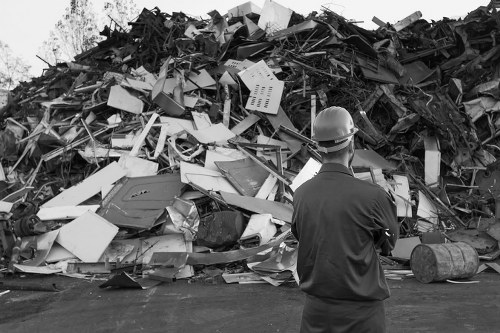Effective Builders Waste Clearance in Chessington: Your Complete Guide

When it comes to builders waste clearance in Chessington, homeowners and contractors alike face the challenge of managing large volumes of construction debris efficiently and responsibly. Proper waste clearance not only ensures a clean and safe environment but also complies with local regulations, helping to avoid potential fines and penalties.
In Chessington, the demand for reliable builders waste clearance services has grown significantly, driven by ongoing residential and commercial construction projects. This article explores the essential aspects of builders waste clearance, the benefits of professional services, and tips for selecting the right provider in Chessington.
Understanding the types of builders waste is crucial for effective clearance. Builders waste typically includes materials like concrete, bricks, tiles, metal scraps, wood, and even hazardous substances such as asbestos-containing materials. Proper sorting and disposal of these materials are paramount to minimize environmental impact and ensure safety.

Why Builders Waste Clearance Matters
Efficient waste clearance plays a pivotal role in the construction industry, contributing to both environmental sustainability and project efficiency. Here are some key reasons why builders waste clearance is important:
- Environmental Protection: Proper disposal of construction waste ensures that harmful materials do not contaminate soil and water sources.
- Regulatory Compliance: Adhering to local waste management regulations helps avoid legal issues and fines.
- Safety: Removing debris from construction sites reduces the risk of accidents and injuries among workers.
- Cost Efficiency: Managing waste effectively can lower disposal costs and streamline project timelines.
By addressing these factors, builders waste clearance contributes to the overall success and sustainability of construction projects in Chessington.

Types of Builders Waste
Builders waste encompasses a wide range of materials generated during construction, renovation, and demolition activities. Understanding these types can help in planning and executing effective waste clearance strategies:
Construction Debris
This includes broken concrete, bricks, mortar, tiles, and other non-hazardous materials generated from building processes.
- Concrete and Bricks: Often recyclable and can be processed for reuse in new construction projects.
- Wood: Depending on its condition, wood can be recycled or repurposed for other uses.
- Metal Scrap: Metals like steel and aluminum are valuable recyclables.
Hazardous Waste
These are materials that pose potential risks to human health and the environment if not handled properly:
- Asbestos-Containing Materials: Requires specialized handling and disposal due to health hazards.
- Paints and Solvents: Must be treated as hazardous waste to prevent contamination.
Proper categorization and disposal of these materials are essential for safe and compliant waste clearance.

Benefits of Professional Builders Waste Clearance Services
Engaging professional builders waste clearance services in Chessington offers numerous advantages over handling waste clearance independently:
Expertise and Efficiency
Professionals have the knowledge and experience to handle various types of construction waste efficiently, ensuring timely and effective clearance.
- Proper Sorting: Professionals can accurately categorize waste for appropriate disposal or recycling.
- Compliance: Ensures all waste is handled in accordance with local regulations and environmental standards.
Safety
Handling builders waste can be hazardous. Professional services equip their teams with the necessary tools and training to manage waste safely, reducing the risk of accidents and health issues.
Cost-Effectiveness
While there is an upfront cost for professional services, the efficiency and proper waste management can lead to long-term savings by minimizing disposal fees and avoiding potential fines.

Choosing the Right Builders Waste Clearance Service in Chessington
Selecting a reliable waste clearance service is critical for the success of your construction project. Consider the following factors when making your choice:
Experience and Reputation
Look for companies with a proven track record and positive reviews from previous clients in Chessington. Experienced providers are more likely to deliver quality service and handle unexpected challenges effectively.
Comprehensive Services
Choose a provider that offers a full range of services, including waste collection, recycling, and disposal. This ensures that all types of waste are managed appropriately.
- Flexible Scheduling: Ability to accommodate project timelines and urgent clearance needs.
- Transparent Pricing: Clear and upfront pricing without hidden fees.
Environmental Responsibility
Opt for companies that prioritize environmentally friendly practices, such as recycling and responsible disposal, to support sustainability efforts in Chessington.

Steps Involved in Builders Waste Clearance
Understanding the process of builders waste clearance helps in managing expectations and ensuring a smooth operation:
- Assessment: Evaluate the type and volume of waste generated to determine the appropriate clearance strategy.
- Collection: Securely gather waste materials from the construction site.
- Sorting and Segregation: Separate recyclable materials from non-recyclable waste.
- Recycling and Disposal: Process recyclable materials and dispose of non-recyclable waste in designated facilities.
- Site Clean-Up: Ensure the construction site is clean and free of debris post-clearance.
Each step is essential for effective and responsible waste management, contributing to the overall success of the construction project.

Environmental Impact of Builders Waste Clearance
Proper builders waste clearance significantly reduces the environmental footprint of construction activities:
Reducing Landfill Use
By recycling and reusing materials, the amount of waste sent to landfills is minimized, conserving space and reducing greenhouse gas emissions.
- Recycling Concrete and Bricks: These materials can be crushed and reused in new construction projects.
- Metal Recycling: Metals can be melted down and repurposed, conserving natural resources.
Energy Conservation
Recycling materials often requires less energy compared to producing new materials from raw resources, thereby conserving energy and reducing overall emissions.
Promoting Sustainable Practices
Implementing effective waste management practices encourages sustainable building methods, contributing to a greener Chessington.

Legal Requirements for Builders Waste Clearance in Chessington
Compliance with local regulations is a critical aspect of builders waste clearance:
Waste Management Regulations
The UK has stringent waste management laws that govern the collection, transportation, and disposal of construction waste. Non-compliance can result in hefty fines and legal consequences.
- Landfill Tax: Fees imposed on waste disposed of in landfills, encouraging recycling and reuse.
- Recycling Obligations: Requirements to recycle certain types of construction waste.
Licensing and Permits
Waste clearance companies must hold appropriate licenses and permits to operate legally. Ensure that your chosen provider is certified and adheres to all regulatory standards.
Asbestos Handling
If your project involves asbestos-containing materials, specialized handling and disposal procedures must be followed to protect public health and the environment.

Cost Factors in Builders Waste Clearance
The cost of builders waste clearance can vary based on several factors:
Volume of Waste
Larger projects generate more waste, which can increase disposal and transportation costs. Accurate assessment of waste volume is essential for budgeting.
- Size of the Construction Site: More extensive sites typically produce more waste.
- Duration of the Project: Longer projects may require multiple clearance sessions.
Type of Waste
Different materials have varying disposal costs. Hazardous waste, such as asbestos, requires special handling, which can be more expensive.
Accessibility
Sites that are difficult to access may incur additional transportation and labor costs. Proper planning can help mitigate these expenses.

DIY Builders Waste Clearance vs. Professional Services
Homeowners and small contractors might consider handling waste clearance independently. However, there are significant differences between DIY clearance and hiring professionals:
Advantages of DIY Clearance
- Cost Savings: Avoiding service fees can reduce overall project costs.
- Control: Direct oversight of the waste management process.
Disadvantages of DIY Clearance
- Time-Consuming: Sorting, transporting, and disposing of waste can be labor-intensive and time-consuming.
- Legal Risks: Potential non-compliance with waste disposal regulations can lead to fines and legal issues.
- Safety Hazards: Handling hazardous materials without proper training and equipment poses significant risks.
Why Choose Professionals?
Professional builders waste clearance services offer expertise, efficiency, and compliance, making them a preferable choice for most construction projects in Chessington.

How to Prepare for Builders Waste Clearance
Proper preparation ensures a smooth and efficient waste clearance process:
- Sort Waste: Segregate materials into recyclable and non-recyclable categories.
- Clear Access Paths: Ensure that waste can be easily transported from the site to the collection point.
- Communicate with Your Provider: Inform the waste clearance company about the types and volumes of waste to be cleared.
Scheduling
Coordinate the clearance schedule with your construction timeline to avoid delays and ensure continuous workflow.
Safety Measures
Ensure that all safety protocols are in place, such as wearing protective gear and securing hazardous materials.

Recycling and Sustainability in Builders Waste Clearance
Emphasizing recycling and sustainability is increasingly important in builders waste clearance:
Recycling Initiatives
Many waste clearance companies collaborate with recycling facilities to process materials like metal, wood, and concrete, reducing landfill dependency.
- Metal Recycling: Metals can be melted and reused, conserving natural resources.
- Concrete and Brick Recycling: These materials can be crushed and reused in new construction projects.
Green Building Practices
Incorporating sustainable waste management practices supports green building initiatives, contributing to environmental conservation and energy efficiency.
Community Impact
Responsible waste clearance benefits the broader Chessington community by maintaining cleaner environments and promoting public health.

Innovations in Builders Waste Clearance
The waste clearance industry is evolving with advancements aimed at improving efficiency and sustainability:
Automated Sorting Technologies
Advanced machinery can sort waste materials more accurately and swiftly, increasing recycling rates and reducing human error.
- Optical Sorters: Utilize sensors to identify and separate different types of materials.
- Robotic Systems: Automate the handling and sorting processes, enhancing productivity.
Eco-Friendly Disposal Methods
Innovative disposal techniques focus on minimizing environmental impact, such as using bio-degradable materials and reducing carbon emissions during transportation.
Digital Waste Management
Digital platforms enable better tracking and management of waste clearance operations, ensuring transparency and accountability.

Case Studies: Successful Builders Waste Clearance in Chessington
Examining real-life examples can provide insights into effective waste clearance strategies:
Residential Renovation Project
A local homeowner in Chessington undertook a comprehensive renovation, generating significant waste. By partnering with a professional waste clearance service, the project achieved efficient sorting and recycling, reducing overall waste by 40%.
- Outcome: Successful project completion with minimal environmental impact.
- Key Takeaway: Early planning and professional assistance are essential for effective waste management.
Commercial Construction Site
A commercial building project required large-scale waste clearance to maintain a safe and productive environment. The chosen service provider implemented automated sorting technologies, streamlining the waste management process and ensuring compliance with all regulations.
- Outcome: Enhanced efficiency and regulatory compliance.
- Key Takeaway: Investing in advanced technologies can significantly improve waste clearance operations.

Future Trends in Builders Waste Clearance
The future of builders waste clearance is geared towards increased sustainability and technological integration:
Circular Economy
Emphasizing the reuse and recycling of materials to create a closed-loop system, reducing the need for new resources and minimizing waste.
- Material Reuse: Designing buildings with materials that can be easily disassembled and reused.
- Resource Efficiency: Maximizing the use of resources at every stage of the construction process.
Artificial Intelligence and Machine Learning
AI-driven solutions can optimize waste management processes, predict waste generation patterns, and enhance recycling rates.
Renewable Energy Integration
Implementing renewable energy sources in waste clearance operations to reduce carbon footprints and promote environmental sustainability.

Conclusion
Builders waste clearance in Chessington is a critical component of successful construction and renovation projects. By leveraging professional services, adhering to regulations, and embracing sustainable practices, stakeholders can ensure efficient waste management that benefits both the environment and their bottom line.
Whether you’re a homeowner undertaking a renovation or a contractor managing a large-scale construction site, prioritizing effective waste clearance is essential. Contact us today to learn more about how our builders waste clearance services in Chessington can support your project’s success.
Book your service now and take the first step towards a cleaner, more sustainable construction process.